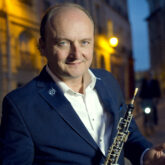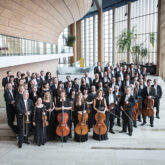
Budapest
François Leleux and the Hungarian National Philharmonic Orchestra
Kobayashi Season Pass 2.
Ludwig van Beethoven: Coriolan Overture, op. 62
Beethoven (1770–1827) composed the Coriolan Overture in 1807, based on a drama by Heinrich Joseph von Collin. The figure of the hero Coriolanus appears is numerous Roman historiographers, and even inspired Shakespeare. Beethoven is thought to have come across the story in the biographies of Plutarch. There were many legends about the courage, exceptional military prowess and oratorical skills of Coriolanus. The people, however, did not like him because he was arrogant and looked down on simple people. He successfully protected Rome from its enemies, yet he was not voted confidence in the consular elections. The offended Coriolanus was even banished from Rome. Revenge followed soon: Coriolan joined forces with his former enemies and led them against Rome. The encircled city sent envoys to its former commander, but Coriolanus was unyielding and declared that Rome must perish. Only when his wife and mother begged him to spare his native city did Coriolanus stand down. However, this cost him his life, for the people of Rome branded him a traitor and killed him.
Collin’s tragedy focuses on a single figure, the main hero, and the narrative is secondary. The text essentially consists of a series of Coriolanus’s self-deprecating monologues. The ending of the story is curious in that Coriolanus takes his own life, sensing that with his momentary lapse he had lost the battle against himself. There is no redemption, no liberating trumpet fanfare. Envisaging the fall of the hero, Beethoven’s Coriolan Overture is one of the composer’s most pessimistic scores.
A. Mozart: Oboe Concerto in C major, K. 314
A. Mozart (1756–1791) was fond of composing concertos for wind instruments, including bassoon, oboe, horn and at the end of his life, the clarinet, and even – albeit with less enthusiasm – even the flute. Typically, then, the D-major flute concerto (K. 314 / K. 285d) is a transcription of the C-major Oboe Concerto under the same K number, dating from 1778. The original oboe concerto had been composed a year earlier for a new member of the Salzburg court orchestra. In terms of its musical idiom it is similar to the 1775 violin concertos, governed by the gallant style. Its three-movement structure follows the usual fast–slow–fast arrangement. It is said that even when composing instrumental music Mozart was writing latent operas. Indeed, the work is brimming with operatic elements: the poetic flow of the slow movement is reminiscent of an emotional aria, while the playful turns of melody in the rondo finale pave the way to the music of Die Entführung aus dem Serail.
Franz Schubert: Symphony No. 4 in C minor “Tragic”
The first six symphonies of Schubert have many ties to Haydn, Mozart and the young Beethoven, and yet they are in every way characteristically Schubertian works. Schubert, who was 19 when he completed the work in 1816, added the title “Tragic”. This is rather misleading in that the fast main theme of the first movement is evocative of not Beethoven’s Fifth Symphony, but rather. the “tempestuous” trend of the early 1770s, the “Sturm und Drang”. The intimate starting melody of Beethovenian beauty in the A-flat-major Andante is contrasted with an almost grotesquely awkward minor theme, which appears twice. Schubert calls the third movement a minuet; however, it is more a scherzo if anything else on account of its tempo and character. Right at the start it surprises the listener by the accentuation converting 3/4 time to 2/4 time. The finale is a sweeping, important movement. Its extensive harmonic scheme and musical fabric clearly betrays the features of nascent Romanticism.



